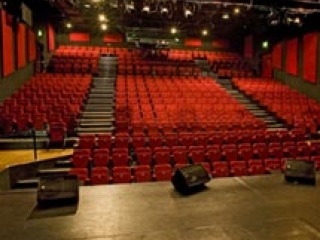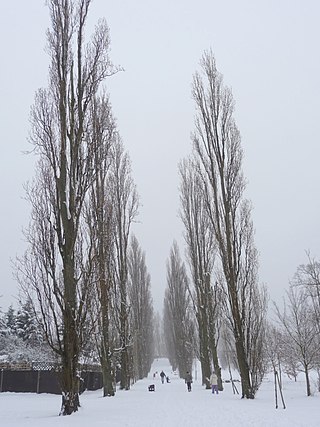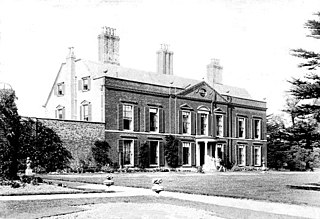
Millfield House is a Grade II* listed building located in Silver Street, Edmonton, London. [1] Previously a private house, it has been used as an arts centre since 1979.

Millfield House is a Grade II* listed building located in Silver Street, Edmonton, London. [1] Previously a private house, it has been used as an arts centre since 1979.
The house is first mentioned in 1796 when it belonged to John Wigston of Trent Park. Later that year it was let to the Ambassador of Austria. The house was valued at £6,300 by 1828, when Robert Mushet of the Royal Mint died there. The house was sold in 1849 to the Strand Union Guardians for a school for London workhouse children, and over the next 40 years several extensions were made to the house which by 1897 housed 400 children. The school was partly self- sufficient complete with two meadows, cultivated land and a herd of cows and some pigs. The children were taught trades; the boys, tailoring, shoe making and carpentry; the girls, housework, needlework and laundering.
In 1913 the school closed and by the beginning of World War I housed Belgian refugees. The house was converted into the St Davids Hospital for epileptics in 1915 by the Metropolitan Asylums Board.
By 1971 the house was acquired by the London Borough of Enfield, who renovated and demolished some of the work house buildings, although a lodge and outbuildings from that period remain as well as an early 20th-century lodge. The house was re-opened as an arts Centre in 1979 and includes the Millfield Theatre. Weir Hall Library was on site until December 2008 but has since been relocated to Fore Street, Edmonton. The space has now been redeveloped as a cafe bar and performance space.
In the gardens one of the few remaining communal air-raid shelters in Enfield can be found (which can be visited). The gardens are open to the public and can be reached by following the Pymmes Brook Trail (the brook flows through the garden) from Pymmes Park. [2]
Adjacent to the garden is the St David's play area. [3] There is also a small library. [4]

The arts centre plays host to comedy, musical, drama, dance, children's and music shows throughout the year. Most shows at the theatre are professional shows which the management bring in for a fee, or a split of the ticket sales. When hired, the venue offers the ability to sell tickets through its own box office, subject to a commission.
At Millfield House several classes take place for adults, children and young people. Including pilates, chess, youth theatre, drama, manga, dance and art Club. The house underwent extensive refurbishment in 2010/11. [5]
In addition the theatre stages an annual traditional pantomime. [6]

The London Borough of Enfield is a London borough in Greater London, England. The main communities in the borough are Edmonton, Enfield, Southgate and Palmers Green. Enfield is an Outer London borough and forms part of North London, being the northernmost borough and bordering Hertfordshire to the north and Essex to the northeast. The local authority is Enfield London Borough Council, based at Enfield Civic Centre. The borough's population is estimated to be 333,794.

Edmonton was a constituency in Greater London, created in 1918 and represented in the House of Commons of the UK Parliament from 2015 until its abolition for the 2024 general election by Kate Osamor, who was elected for the Labour and Co-operative party; she briefly lost the Labour whip between January and May 2024.

Edmonton is a town in north London, England within the London Borough of Enfield, a local government district of Greater London. The northern part of the town is known as Lower Edmonton or Edmonton Green, and the southern part as Upper Edmonton. Situated 8.4 miles (13.5 km) north-northeast of Charing Cross, it borders Enfield to the north, Chingford to the east, and Tottenham to the south, with Palmers Green and Winchmore Hill to the west. The population of Edmonton was 82,472 as of 2011.

New Southgate is a residential suburb straddling three Outer London Boroughs: a small part of the east of Barnet, a south-west corner of Enfield and in loosest definitions, based on nearest railway stations, a small northern corner of Haringey in North London, England where estates merge into Bounds Green.

The London Borough of Enfield is the northernmost of the Outer London boroughs. The borough lies within the Metropolitan Green Belt, and several of its 123 or more parks and open spaces are part of it. The ancient Enfield Chase, remnants of which still exist, occupied much of the area. In addition to many playgrounds and sports facilities, the main areas of public open space are:

Arnos Grove is an area of north London, England, within the London Borough of Enfield. It is centred 7.5 miles (12 km) north of Charing Cross. It is adjacent to New Southgate. The natural grove, larger than today, was for many centuries the largest woodland in the chapelry of Southgate in the parish of Edmonton. It became inter-related with Arnos Park when its owner was permitted to enclose much of its area through the widespread legal practice of inclosure of the common land to create the former park, the heart of which is now public parkland.

North Middlesex University Hospital, known locally as North Mid, is a district general hospital in Edmonton in the London Borough of Enfield. The hospital is managed by North Middlesex University Hospital NHS Trust.

Pymmes Brook is located in North London and named after William Pymme, a local land owner. It is a minor tributary of the River Lea. The brook mostly flows through urban areas and is particularly prone to flooding in its lower reaches. To alleviate the problem the brook has been culverted in many areas. Part of it is a Site of Borough Importance for Nature Conservation, Grade II.

Pymmes Park is located in Edmonton, London and is bordered by the North Circular Road.

Salmons Brook is a minor tributary of the River Lea, located in the London Borough of Enfield.

The Pymmes Brook Trail is located in the London Boroughs of Barnet, Enfield and Haringey and is just under 13 miles (21 km) long. The brook is named after William Pymme, a local landowner.

Millfield Arts Centre comprises Millfield Theatre and Millfield House in Edmonton and The Dugdale Centre in Enfield Town.

Monken Hadley Common lies within the Monken Hadley Conservation Area, and is listed as a “Site of Borough Importance for Nature Conservation, Grade I,” by the London Borough of Barnet. It is registered common land, and it is owned by the Trustees of Monken Hadley Common.

Dugdale Arts Centre (DAC) is situated in the centre of Enfield Town. It contains a 150-seat studio theatre, the Museum of Enfield, workshops and small-scale performance spaces and an award-winning cafe restaurant specialising in locally made and sustainable food.

Millfield Theatre forms part of Millfield Arts Centre, which encompasses Millfield Theatre and Millfield House in Edmonton, and The Dugdale Centre in Enfield Town. The theatre is owned, managed and funded entirely by London Borough of Enfield. It has 17 full-time staff working on site at the theatre, and employs many more casual staff. Ushers at the theatre are all volunteers. The 18th Century Millfield House houses the theatre's administration and contains rooms which are available for hire, and also plays host to a number of educational classes and workshops for children and adults.

The Arnos Park Viaduct is a railway viaduct of 34 brick arches that was built as part of the extension of London Underground's Piccadilly line from Finsbury Park in the south to Cockfosters in the north. It was built in 1932 and opened in 1933. It starts on the southern edge of Arnos Park soon after Arnos Grove station and ends on the northern side of the park, where the line enters a tunnel that continues to Southgate.

Oakwood Park is a public park in Oakwood, in the London Borough of Enfield, on land that was formerly part of Enfield Chase. It opened in 1929 and comprises 64 acres of land. It is notable for its commemorative avenue of poplar trees, an avenue of scarlet oaks planted by mayors of Enfield, and an ice well that was built by Samuel Sugden, on whose estate of Oak Lodge the park was largely built and after which it was named.
William Pymme was a landowner in Edmonton, now in London, a member of the Pymme family who had been granted land by Edward II in the 14th century.

Pymmes House was a house built by William Pymme in 1327 in what is now Pymmes Park, in Edmonton, London. It had a succession of notable owners, particularly in the Elizabethan period and was remodelled and rebuilt several times. It was demolished after a fire in 1940.
{{cite web}}: Missing or empty |title= (help)[ title missing ]